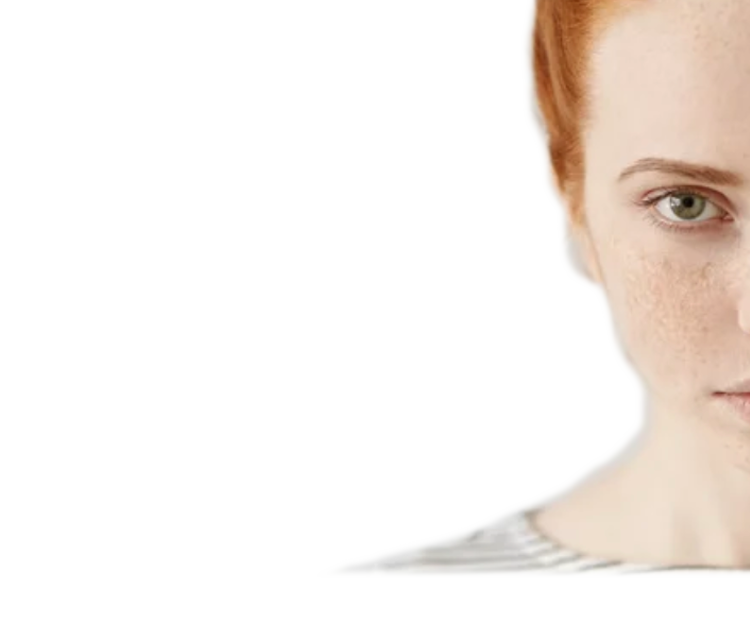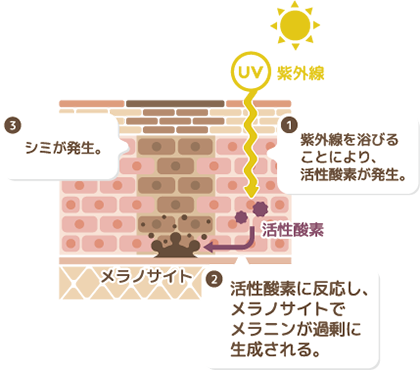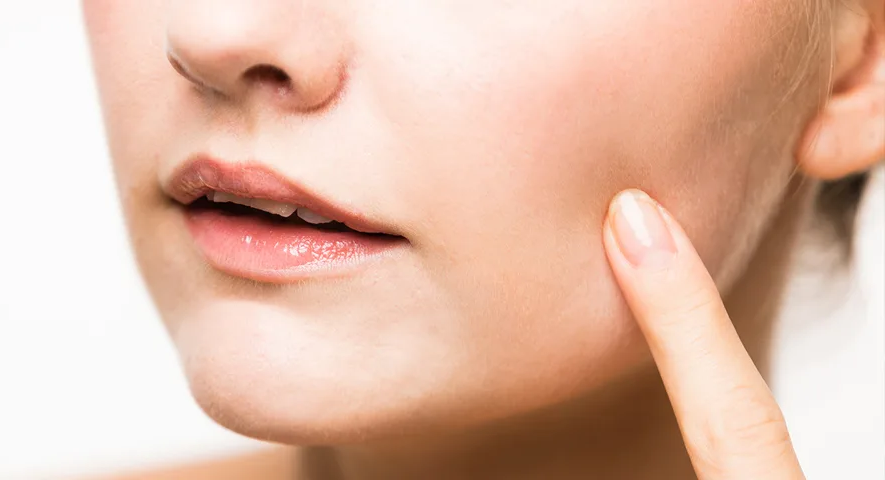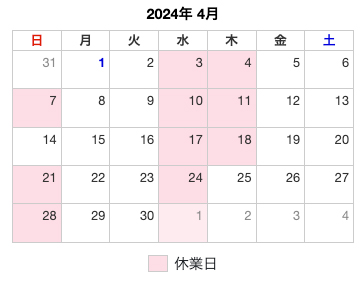Blot and freckles

Blot and freckles
Treatment tailored to the type of stain
Broadly speaking, skin is made up of the outermost epidermis and the inner dermis, but it is the epidermis that is deeply involved in dark spots.
Age spots are areas of the skin where melanin increases and accumulates in the epidermis of the skin, making it darker than the skin color and appearing brown.
Melanocytes (pigment cells) in the lowest basal layer of the epidermis produce melanin.When the skin is exposed to ultraviolet rays, an enzyme called tyrosinase becomes active and a pigment called melanin is produced within melanocytes.
When this melanin is delivered to keratinocytes, it protects the cell nucleus from ultraviolet rays.Melanin is actually not a bad substance, but plays an important role in protecting the skin.
Cells in the epidermis undergo a cycle of ``turnover'' (metabolism), where they are reborn as new cells every 28 days.Cells in the basal layer divide and are pushed up to the surface of the skin, eventually turning into plaque and peeling off.
Normally, due to epidermal turnover, melanin is pushed out to the stratum corneum and falls off, so melanin does not accumulate.
However, when exposed to ultraviolet rays, melanocytes within the epidermis become activated and produce excessive melanin, changing the skin's color.
When damage from UV rays accumulates over a long period of time, melanin is overproduced, and as we age, melanin is not excreted and accumulates in the epidermis, causing age spots.
Age spots are areas of the skin where melanin increases and accumulates in the epidermis of the skin, making it darker than the skin color and appearing brown.
Melanocytes (pigment cells) in the lowest basal layer of the epidermis produce melanin.When the skin is exposed to ultraviolet rays, an enzyme called tyrosinase becomes active and a pigment called melanin is produced within melanocytes.
When this melanin is delivered to keratinocytes, it protects the cell nucleus from ultraviolet rays.Melanin is actually not a bad substance, but plays an important role in protecting the skin.
Cells in the epidermis undergo a cycle of ``turnover'' (metabolism), where they are reborn as new cells every 28 days.Cells in the basal layer divide and are pushed up to the surface of the skin, eventually turning into plaque and peeling off.
Normally, due to epidermal turnover, melanin is pushed out to the stratum corneum and falls off, so melanin does not accumulate.
However, when exposed to ultraviolet rays, melanocytes within the epidermis become activated and produce excessive melanin, changing the skin's color.
When damage from UV rays accumulates over a long period of time, melanin is overproduced, and as we age, melanin is not excreted and accumulates in the epidermis, causing age spots.

Why do stains form?
For various reasons, melanin is overproduced, and the turnover* cycle becomes long and metabolism slows down. When the melanin that should normally fall off is not excreted from the epidermis, it accumulates, resulting in pigmentation (spots). It will be.Ultraviolet rays are the main cause of stains.
Exposure to UV radiation for many years can damage the skin (photoaging), reduce its ability to heal, and reduce its ability to excrete melanin. Irregular living, smoking and stress promote aging and increase active enzymes. Active enzymes stimulate melanocytes and cause overproduction of melanin.
Excessive irritation to the skin can also cause pigmentation. If the skin is rubbed strongly during makeup removal or face washing, melanin may be produced by the stimulation and pigmentation may occur.
In particular, melasma, a stain that is peculiar to women, is exacerbated by the irritation of the skin.
The same goes for acne. Acne often rubs the skin strongly and causes a spot-like mark of pigmentation after inflammation. Just hitting the hair can spread inflammation and cause pigmentation.
Exposure to UV radiation for many years can damage the skin (photoaging), reduce its ability to heal, and reduce its ability to excrete melanin. Irregular living, smoking and stress promote aging and increase active enzymes. Active enzymes stimulate melanocytes and cause overproduction of melanin.
Excessive irritation to the skin can also cause pigmentation. If the skin is rubbed strongly during makeup removal or face washing, melanin may be produced by the stimulation and pigmentation may occur.
In particular, melasma, a stain that is peculiar to women, is exacerbated by the irritation of the skin.
The same goes for acne. Acne often rubs the skin strongly and causes a spot-like mark of pigmentation after inflammation. Just hitting the hair can spread inflammation and cause pigmentation.

About types of spots and dullness
Effective treatment can be achieved by matching the treatment to the type of stain.
Senile pigment spots
This is a pigmented spot that appears after middle age.There is mild thickening of the epidermis and an increase in melanin pigment, but the cause is currently unknown.It is a symptom of photoaging, and is thought to be greatly affected by repeated exposure to UV rays on a daily basis.
solar pigment spots
It is a general stain that can be caused by sunburn or aging.
Sparrow egg spot
Freckles are a kind of pigmented spots that appear on the skin and are commonly called freckles.It is genetically related and is more common in fair-skinned people.
In areas with pigment spots, the pigment cells in the skin become larger and melanin increases.
In areas with pigment spots, the pigment cells in the skin become larger and melanin increases.
Melasma
It appears as light brown spots on the face.They appear symmetrically and in almost the same shape and size, often appearing around the cheekbones and spreading over a wide area.
Blemish treatment
Ultima
Improves stains and dullness.It causes less damage to the skin and is recommended for beautiful skin and acne treatment.Heat energy can be efficiently applied to the dermal layer without being affected by the amount of melanin in the epidermis.
Beautiful skin toning
It adjusts the skin texture and also performs peeling at the same time.The "WON-COSJET TR" introduced at our hospital has received great praise overseas and is a system that eliminates the drawbacks of laser irradiation systems.
Rabian
Recover your skin and make it smooth.Lavian is a skin care treatment system that is popular in South Korea, a beauty powerhouse.Lavian uses a wavelength in the infrared region of 1927nm to restore skin.
Hypervitamin infusion
Suppresses melanin production and fades age spots and pigmentation.It is currently being used as a new adjunct/alternative therapy for cancer treatment, as well as for the prevention of viral diseases and for anti-aging care due to its cell activation effects.
Beauty drip
Suppresses melanin production and fades age spots and pigmentation.In addition to several active ingredients that are effective for beautiful skin, this treatment also detoxifies with ingredients that quickly remove toxins from the body, and is expected to efficiently make your skin beautiful.It can also be expected to be highly effective for melasma.
Placenta injection
Eliminate dark spots and dullness, leaving your skin smooth and smooth.There are many effects of placenta treatment, but in addition to medical effects such as improving immunity and recovering from fatigue, you can also expect skin beautification effects.
Drink sunscreen helio care
Protects your skin from UV rays to prevent stains.HELIOCARE, developed based on the idea that sunburn is the skin's greatest enemy, is a brand that focuses on thorough sunscreen measures from inside and outside the body, and has a track record of providing products to hospitals in 50 countries around the world. there is.
Topical medicinesVitamin C derivative, vitamin A inductionOral medicines such asVitamin C, tranexamic acid(Take 1mg or more a day. Covered by insurance).






